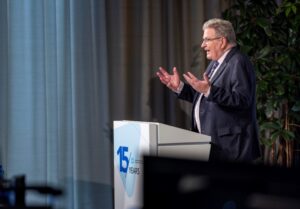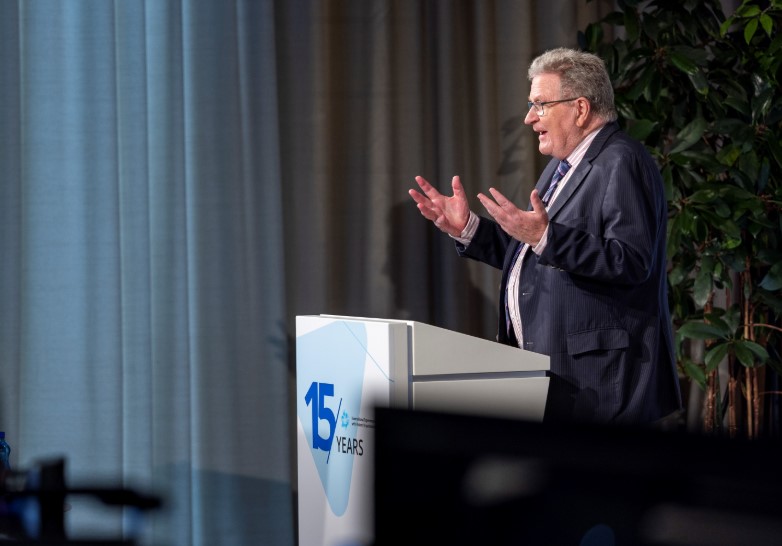This March, RCA Chief Executive Richard Vines was invited to speak at the International Experience Exchange with Patient Organisations (IEEPO) in Switzerland, designed to unite and empower patient communities to shape their healthcare systems.
Richard spoke about the initiatives of RCA and the National OncologyThe study and treatment of tumours, cancers. AllianceGroups working together (NOA) as an example of best practice collaborative advocacy.
Reflecting on the opportunity, Richard said,” I was honoured to be part of IEEPO and so impressed by the energy and enthusiasm of all those involved. It was great to meet and share experiences with patient organisations from six continents. We all share the same passion to build a better world for our patients.”
Here is an excerpt from his talk:
“My grandchildren, when they are united, usually around ice-cream, are a highly effective alliance. If each of them wanted something different it would be easy for “Pa” to say no to different requests. However, if they are all clamouring for the same thing, then it is pretty irresistible.
It teaches me that to be successful as an alliance, we have to focus on our common goals.
This was very much the approach we took when forming the National Oncology Alliance Project, which delivered the ‘Vision 20-30: Building an Australian Cancer Futures Framework’ report in 2020 – a contributing catalyst for the development of an Australian CancerA disease where abnormal cells split without control and spread to other nearby body tissue and/or organs. Cancer cells can also spread to other parts of the body through the bloodstream and lymph systems. Plan.

Determining our common goal
Our alliance needed a simple ask and a simple structure. We asked ourselves, “What do we think is important? What do we want to do?”
We were very much aware that Australia didn’t have a comprehensive National Cancer Plan. We knew that individual diseases like lung cancer, like bloodhello cancers and individual states (provinces or cantons) all had different cancer plans, but there was nothing binding them together. We thought that would be a fundamental thing that we should do, and that the planning would be as important as the plan.
Advocating for our goal and changing the conversation
So how would we do this?
Through the alliance, we would prepare an optimistic report – not one that criticised the current state of treatment, not one that criticised the current government, not one that did anything retrospectively – one that said (this was in 2020): we’re going to look forward ten years at the treatment types that are coming and the way that technology and patient care is going to evolve over those ten years. We could then present that to government and say all of this change is coming. We need a comprehensive plan to go forward with. This is how the Vision 2030 report was born.
Forming the National Oncology Alliance
We decided to take this concept out to those groups and people who had expressed an interest in being part of a National Oncology Alliance and then start to move forward. We appointed an advisory committee – I stress advisory not steering – we had representatives from major stakeholder groups including patient groups, patients, clinicians and industry.
They met regularly for briefings but fundamentally they were providing advice and our team was busy with consultants and various other people preparing to write this Vision 2030 report. Whilst that was working we felt we needed a different way that would allow us to engage with all members of the community.
Engaging with the community
To do this, we ran 13 topic specific virtual workshops on subjects as varied as precision oncology, radiation oncology, the use of artificial intelligence in areas such as radiation oncology and data analysis. We discussed health economics, genomics and more.
We had excellent participation from the community – our topics were relevant and our speakers highly regarded. As I recall, we never had less than 100 people on one of these workshops. So by the end of those 13 workshops, we had consulted really, really widely with a whole range of experts. We had a massA growth of cells that come together to make a lump, either big or small, and may or may not be cancer. of content to inform the report, but we also had over a thousand people from within the cancer community who participated in those workshops and they had been able to ask questions, see and understand our work.
Presenting a solution, not a problem
From there we went forward, we wrote the report, and importantly, we could go to government and say to them, “Here’s all the people we’ve spoken to. They are all supportive of you developing an Australian Cancer Plan and here is a futures framework that we’ve developed.” It involves no criticism. It was nothing that the government needed to defend because we were forward looking, we weren’t looking back. This was critical to their engagement. All we were saying was, this is what’s coming – we need a plan.
I think there are times when government should be criticised. I think there are times when government should be held to account on behalf of our patients. But by and large, if you mount a negative campaign in this space, a government has to survive two days, thereabouts, of media that you might generate before it’s all forgotten. In my view, you’re much better off working constructively, working creatively with government and providing opportunities that fit within the broad bounds of what is realistic to achieve.
Final thoughts
I think for us, the lesson out of the alliance was that it was a single issue.
So how did we go?
The Government, Federal Health Minister, Greg Hunt, mandated the development of the Australian Cancer Plan and announced it at our national conference, CanForum. We’re now, I think about a month away from the final version of that plan being released. It’s done an amazing job of coalescing all of those other sub plans into something that’s coherent and forward looking.
And I think that’s the message that I’d love to leave you with; that you can perform advocacy in a way that is sensible, that is collaborative. The key to an alliance is that you’re coalescing around one goal and you stay within that one goal.
An alliance with one voice, and one goal makes it easy for decision makers to say “Yes, we can do this because this is what all of you want, and that means it’s safe.”
